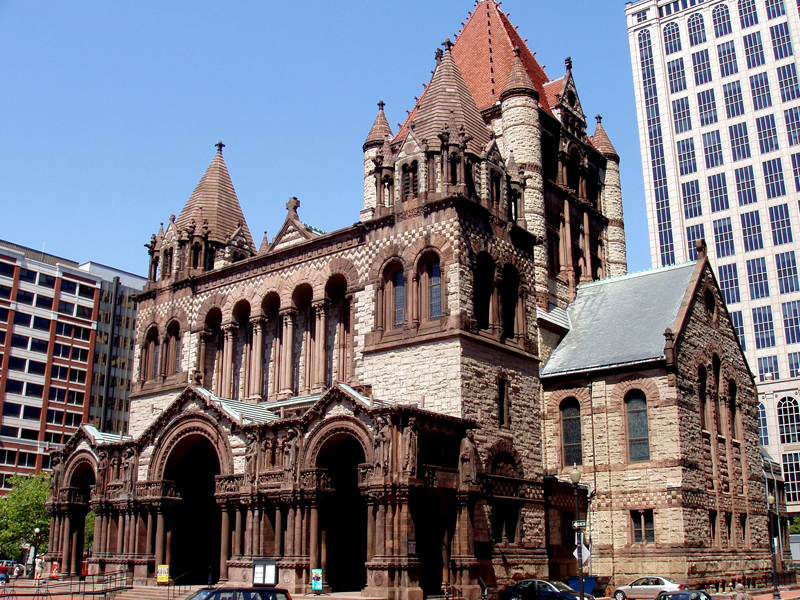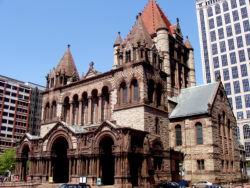Henry Hobson Richardson
Louisiana-born architect H. H. Richardson is one of the most notables American architect of the late nineteenth century.

Wikimedia Commons.
Reproduction of a contemporary color photograph of Trinity Church in Boston's Copley Plaza.
Though his designs were constructed outside his native state, Louisiana-born architect Henry Hobson (H. H.) Richardson is considered one of the greatest American architects of the late nineteenth century. His most noted works include Trinity Episcopal Church in Boston, Massachusetts, and the Allegheny County courthouse and jail in Pittsburgh, Pennsylvania. In an 1884 poll of architects taken by The American Architect and Building News, Richardson designed five of the ten buildings voted best in the country; Trinity placed first, ahead of the U.S. Capitol. Richardson’s distinctive style, now referred to as Richardsonian Romanesque, continues to play an important role in architectural history more than a century after his death.
Born in 1838 on his family’s plantation near Vacherie, Richardson grew up in a townhouse on Julia Street in New Orleans. After graduating from Harvard University, he traveled to Paris in 1860 to attend the Ecole des Beaux-Arts. On his return to the United States in 1865, he set up an architectural practice in New York City. He moved to Boston in 1874, where he remained until his death in 1886.
Despite his prestige and fame during his lifetime, Richardson’s influence in Louisiana appeared only after his death. The most direct impact can be seen in the former Howard Memorial Library (now part of the Ogden Museum of Southern Art) in New Orleans. Begun in 1886 and completed in 1889, the library was designed by Shepley, Rutan and Coolidge, a Boston architectural firm that grew out of Richardson’s practice. Based on the design for one of Richardson’s unexecuted works—the Hoyt Public Library in East Saginaw, Michigan—the library has all the hallmarks of Richardson’s work: rusticated stone exterior surfaces, Romanesque round arches, and sculptural details.
The largest collection of buildings in the Richardsonian manner in Louisiana can be found on Tulane University’s campus. Built in 1894 by the firm of Harrod and Andry, Gibson Hall clearly recalls Richardson’s influence, as does Tilton Memorial Hall (formerly F. W. Tilton Library), built in 1901 by Andry and Bendernagel. This firm also designed the Richardson Memorial Building (originally built for the School of Medicine) in 1908. All three buildings are executed in rough-cut limestone with numerous round arches, two major elements of the Richardsonian Romanesque. The former chemistry and biology buildings on the main quadrangle, built in brick, recalled Richardson’s later designs, which featured more simplified detailing without expensive stone carvings.
Although residential designs using Richardson’s style are less common than institutional buildings in Louisiana, a few houses were built in New Orleans. Built by Sully and Toledano, the 1889 Isidore Newman house was demolished in 1972. The Richardson-influenced William Perry Brown house, built by Favrot and Livaudais between 1902 and 1907, is located at 4717 St. Charles Avenue.
One factor limiting Richardson’s influence in Louisiana was the state’s lack of building stone—a mainstay of Richardsonian design. Obtaining this material elsewhere proved prohibitively expensive. Still, Richardson’s architectural style played an important role in the development of Louisiana architecture. Moreover, Richardson shaped American architecture perhaps more than any other Louisiana architect.
